
Middelburg, capital of the province of Zeeland, ranks fourth in the list of monumental cities in the Netherlands, with no less than 1100 protected buildings, an impressive number for what is quite a small town. It is also an old city, founded in the 9th century as one of three fortresses (middel=middle, burg=fortress) built to defend the island of Walcheren against the Vikings. This fortress evolved into a trade centre, and in ca. 1123 was extended with an abbey which became a religious centre of major importance. For centuries the islands of Zeeland were claimed by Flanders and Holland. In 1323 Holland won the conflict, but a Flemish influence remained. The trade with Flanders, England and France lead to an enormous growth of the city. In 1559 abbot Nicolaas de Castro became the first and only bishop of the newly founded diocese of Middelburg. The 80-years War started a new period. In 1574, after a siege of two years, the city was forced to surrender to the protestant army of the prince of Orange. The catholics were forced to leave the city and the three big catholic churches were confiscated; two of these, the St. Maarten and the St. Pieter were demolished in 1576 and 1834 respectively. In May 1940 German planes and artillery destroyed much of the centre. The most important monuments were restored or reconstructed later.
Middelburg, de hoofdstad van de provincie Zeeland, staat op de vierde plaats in de lijst van meest monumentale steden in Nederland, met niet minder dan 1100 beschermde gebouwen, een indrukwekkend aantal voor deze vrij kleine stad. Het is ook een oude stad, gesticht in de 9e eeuw als een van de drie forten die werden gebouwd om het eiland Walcheren te verdedigen tegen de Vikingen. Het fort ontwikkelde zich tot een handelscentrum en werd rond 1123 uitgebreid met een abdij die uitgroeide tot een religieus centrum van groot belang. Al eeuwenlang werden de Zeeuwse eilanden opgeŽist door Vlaanderen en Holland. In 1323 won Holland het conflict, maar de Vlaamse invloed bleef. De handel met Vlaanderen, Engeland en Frankrijk leiden tot een enorme groei van de stad. In 1559 werd abt Nicolaas de Castro de eerste en enige bisschop van het nieuwe bisdom Middelburg. Met deTachtigjarige oorlog begon een nieuwe periode. In 1574, na een beleg van twee jaar, werd de stad gedwongen om zich over te geven aan het protestantse leger van de prins van Oranje. De katholieken werden gedwongen om de stad te verlaten en de drie grote katholieke kerken werden in beslag genomen; twee van deze, de St. Maarten en de St. Pieter, werden in respectievelijk 1576 en 1834 afgebroken. In mei 1940 vernietigden Duitse vliegtuigen en artillerie een groot deel van het centrum. De belangrijkste monumenten zijn gerestaureerd of later gereconstrueerd.
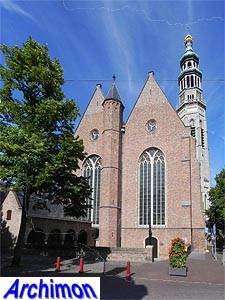
The Gothic Abdijkerk, the church of the abbey, is the only remaining big medieval church in Middelburg. The church is divided in three seperate spaces and is used for protestant services, concerts and exhibitions. The tower, named Lange Jan ('long John'), is 85 metres high and dominates the whole island of Walcheren.
Location: Groenmarkt 1
De gotische Abdijkerk is de enige overgebleven grote middeleeuwse kerk in Middelburg. De kerk is verdeeld in drie aparte ruimtes en wordt gebruikt voor protestantse diensten, concerten en tentoonstellingen. De toren, genaamd Lange Jan, is 85 meter hoog en domineert het hele eiland Walcheren.
Locatie: Groenmarkt 1

The Gasthuiskerk ('hospital church') was built in 1493-1494 as the chapel of the St. Barbara hospital. After the Reformation it was used by English merchants for ten years, after which it became a reformed church. In 1798 it was returned to the catholic community, which continued to use it until 1846. Since that year it has been used by various branches of the Gereformeerden.
Location: Lange Delft 94
De Gasthuiskerk werd gebouwd in 1493-1494 als de kapel van het St. Barbaragasthuis. Na de Reformatie werd het tien jaar lang gebruikt door Engels handelaren en werd daarna een hervormde kerk. In 1798 werd het gebouw teruggegeven aan de katholieke gemeenschap, die het tot 1846 gebruikte. Na dat jaar is het gebruikt door verschillende Gereformeerde gezindtes.
Locatie: Lange Delft 94
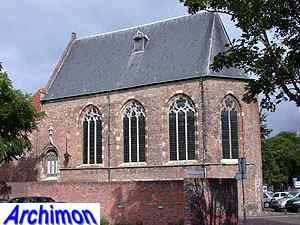
This
former chapel of an Alexian
monastery was built in the 15th century and became the English
church
in 1629, after having been used as a weaving-mill since 1592. It's now
a reformed church.
Location: Simpelhuisstraat 10
Deze voormalige kapel van een Cellebroedersklooster is gebouwd in de 15e eeuw en is sinds 1629 de Engelse kerk, na eerst vanaf 1592 te zijn gebruikt als een weverij. Het is nu een hervormde kerk.
Locatie: Simpelhuisstraat 10
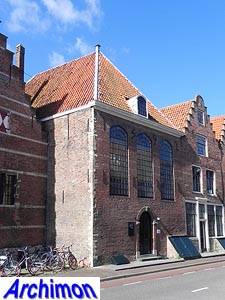
The old Mennonite church is a former house which in 1629 was rebuild into a church. After 1889 it was used by the Salvation Army.
Location:
Hoogstraat 20
De oude
Doopsgezinde kerk is een voormalig huis dat in 1629 werd
omgebouwd tot een kerk. Na 1889 werd het gebruikt door het Leger des
Heils.
Locatie:
Hoogstraat 20
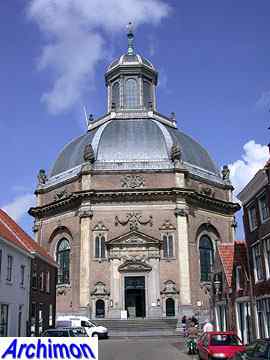
The Oostkerk was the first church in Middelburg specially built for protestant services. This octagonal centralizing church in Classical style was finished in 1667, after 20 years.
Location: Oostkerkplein 1
De Oostkerk was de eerste kerk in Middelburg die speciaal werd gebouwd voor de protestantse diensten. Deze achthoekige centraalbouw in classicistische stijl werd voltooid in 1667, na 20 jaar.
Locatie: Oostkerkplein 1
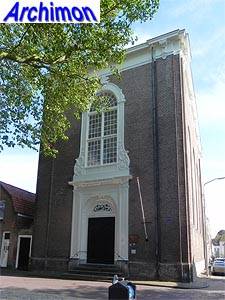
The Lutheran church was built in 1737-1742. The tall one-aisled building in Louis XIV-style was designed by architect Jan de Munck.
Location: Zuidsingel 70
De Lutherse kerk stamt uit 1737-1742. Het hoge eenbeukige gebouw in Lodewijk XIV-stijl.is ontworpen door architect Jan de Munck.
Locatie: Zuidsingel 70

The current Mennonite church is a building in neo-Renaissance style, designed by K. Stoffels and built in 1889.
Location: Lange Noordstraat 62
De huidige Doopsgezinde kerk is een gebouw in neorenaissance-stijl, ontworpen door K. Stoffels en gebouwd in 1889.
Locatie: Lange Noordstraat 62
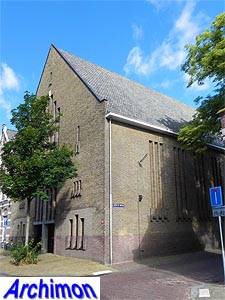
This
church in moderate
Expressionist
style is the Gereformeerde
Hofpleinkerk, designed by A. de Poorte and built in 1930-1931.
Location: Hofplein 13
Deze kerk in gematigde expressionistische stijl is de Gereformeerde Hofpleinkerk, ontworpen door A. de Poorte en gebouwd in 1930-1931.
Locatie: Hofplein 13

The Roman Catholic H.H. Petrus en Paulus was built in 1949-1951 in Traditionalist style, as a replacement for the previous church which was destroyed in 1940. Architect was C.M. van Moorsel.
Location: Lombardstraat 3
De rooms-katholieke H.H. Petrus en Paulus werd gebouwd in 1949-1951 in traditionalistische stijl, als vervanging van de vorige kerk die in 1940 was verwoest. De architect was C.M. van Moorsel.
Locatie: Lombardstraat 3